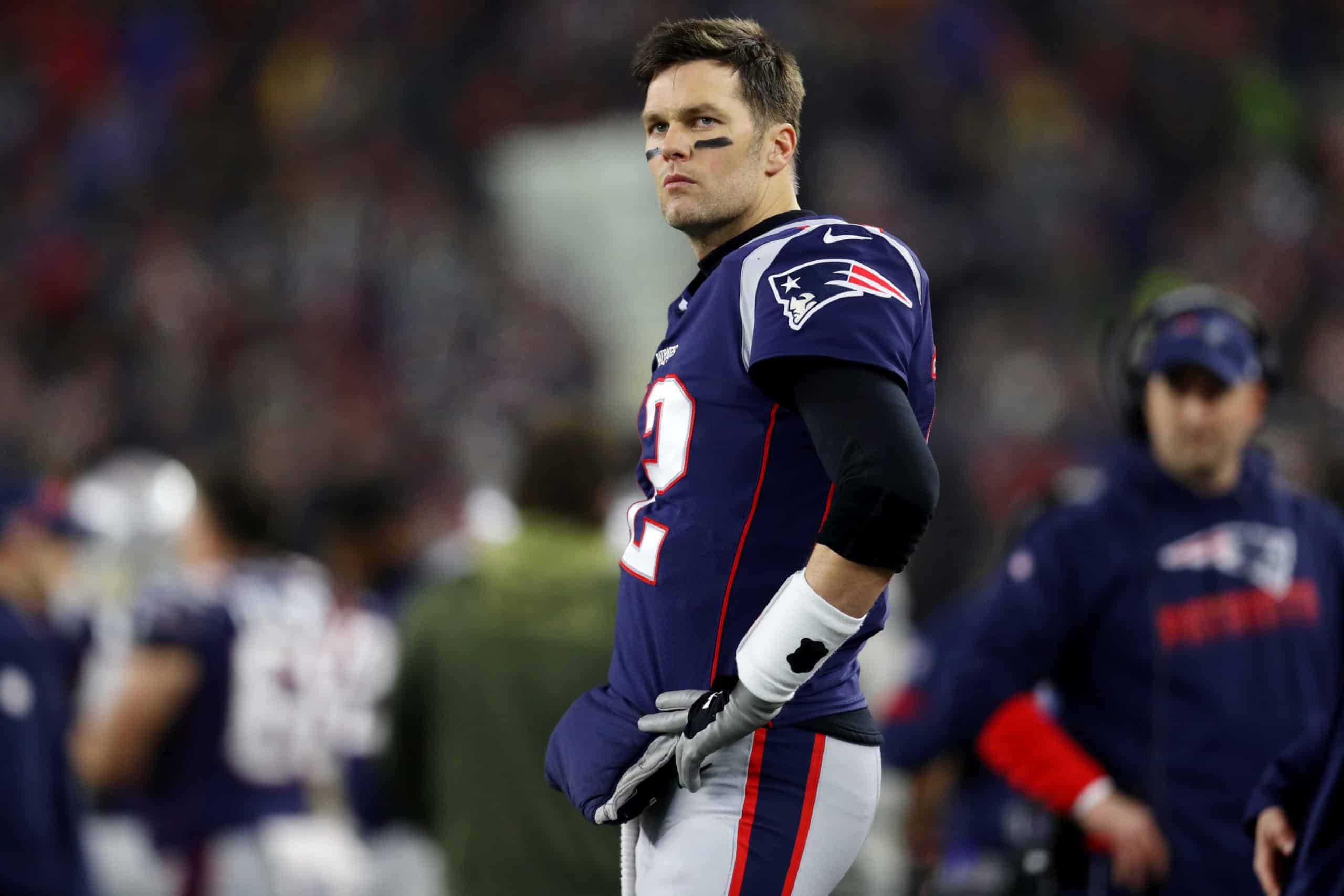NFL free agency opens in less than two weeks and nothing stands out more than the number of veteran quarterbacks available. The potential quarterback movement could be unprecedented for one offseason.
There are a number of ways to look at quarterback performance and one that has gotten more popular over the past few seasons comes from adjusting completion percentage by the depth of target and comparing that to league average.
Using our new completion percentage by depth tool from Sharp Football Stats, which allows users to do things such as compare players, sort by down, distance, position targeted, and personnel grouping, we can take a look at some things we can learn about this group of free agent quarterbacks.
Dak Prescott and Drew Brees are staying put and that’s good
The free agent passers most likely to stay with their current team are Dallas Cowboys quarterback Dak Prescott and New Orleans Saints quarterback Drew Brees.
Brees has already said he plans to return to New Orleans, which takes away any mystery surrounding his 2020 status. Prescott and the Cowboys couldn’t come to a long-term deal before the 2019 regular season began and Prescott responded with the best season of his career. Reports indicate the Cowboys will place the franchise tag on Prescott if a deal can’t be reached before the tag deadline but his price should only go up the longer the deal takes to be completed.
Both are coming off stellar seasons.
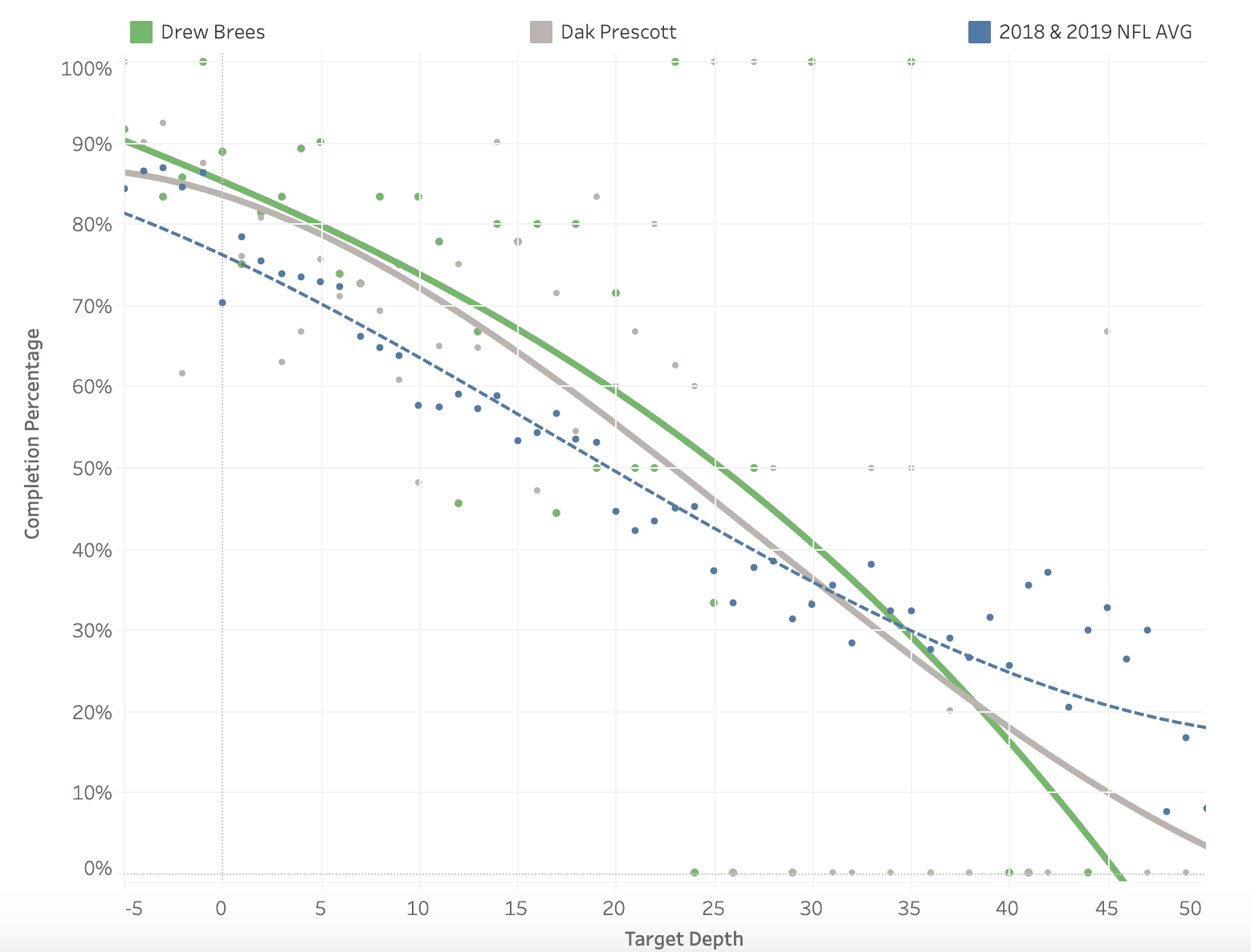
Per Sports Info Solutions, Prescott led all quarterbacks in Expected Points Added in 2019 and he was above average in completion percentage to every area of the field until the ball traveled 30 yards in the air. But Prescott was still a deep passer with more attempts that traveled 20-29 yards in the air (where he was quite good) than those that traveled 30 or more.
Brees, again, was pinpoint just about everywhere he threw. The biggest difference between these two was the depth of average targets. Brees kept most of his passes short with a 6.7 aDOT, which was the fourth-lowest among qualified quarterbacks per Next Gen Stats. Meanwhile, Prescott’s 9.3 aDOT was the sixth-highest among quarterbacks in 2019.
With both set to return in one way or another, the Saints and Cowboys should remain top contenders in the NFC thanks to the play of their quarterbacks.
Tom Brady’s receiver shortcomings
There might not be a bigger domino to fall in free agency than the identity of Tom Brady’s 2020 team. Brady and the Patriots had a down year offensively in 2019, which wasted a performance of one of the league’s best defensive units — one that was on a historic pace through the first half of the season.
Now comes the reality that Brady might not be in New England for the 2020 season and beyond. While Brady is the biggest name on the market, the question becomes what level of performance is Brady able to give a team, whether it’s New England or not, entering his age-43 season.
Like most quarterbacks as they get older, Brady relied on shorter passes in 2019; 75.4% of Brady’s attempts came within 10 yards of the line of scrimmage last season. That was slightly up from the 72.8% rate in 2018 with both rates well above the 66.4% rate in 2017. The biggest difference between 2018 and 2019 was the efficiency on those short passes. (In the graph below, 2018 Brady is in green and 2019 Brady is gray.)
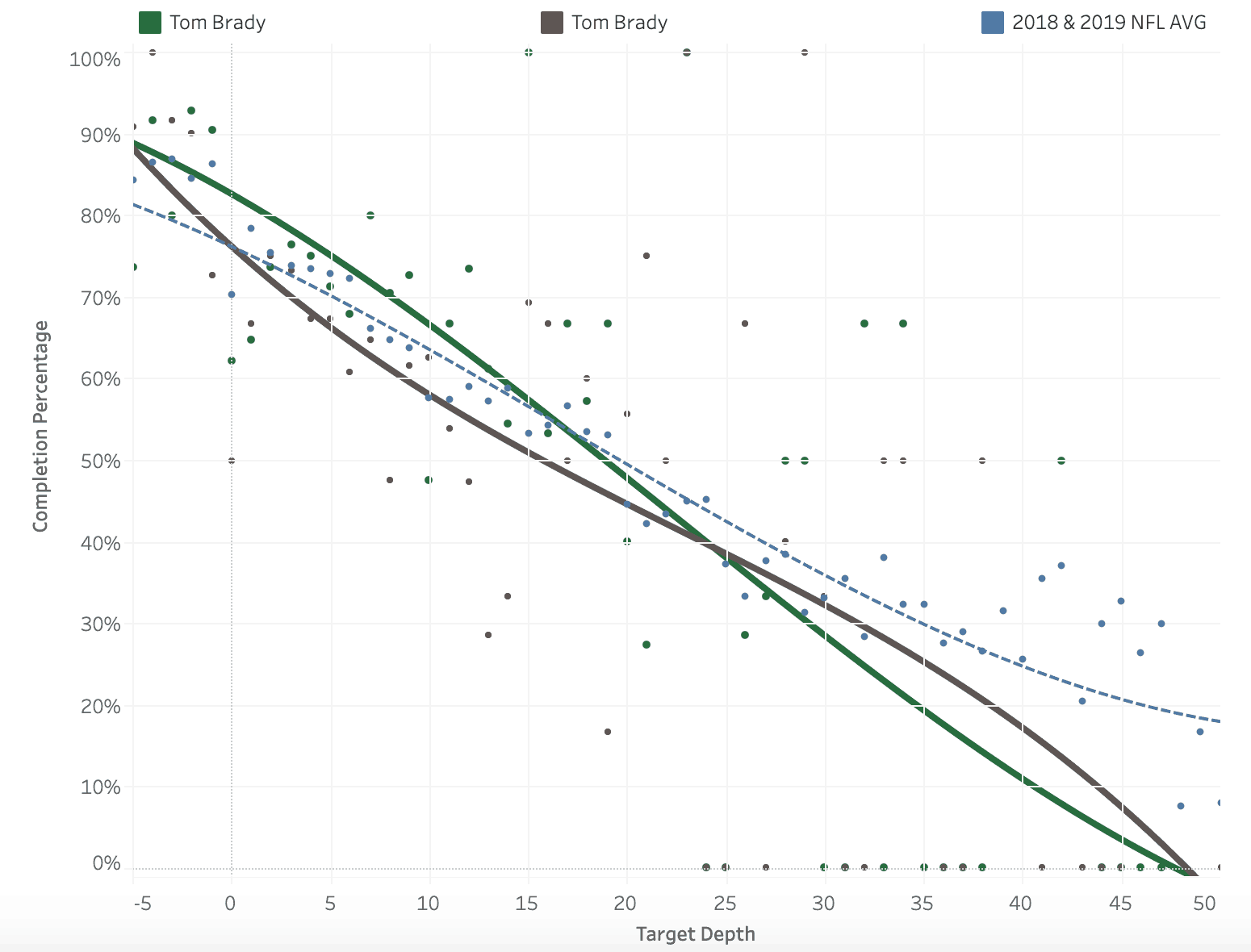
Playing a part in this was the wide receiver play this past season. There was a time during 2019 when the Patriots looked like they might be loaded at receiver, but that thought did not last long and it turned into one of the team’s weakest positions by the end of the season. Between the lack of talent and a lack of trust from the quarterback, the receiver play made a huge impact on those short passes. Take a look at the 2018 (green) vs 2019 (gray) graph again with just targets to wide receivers:
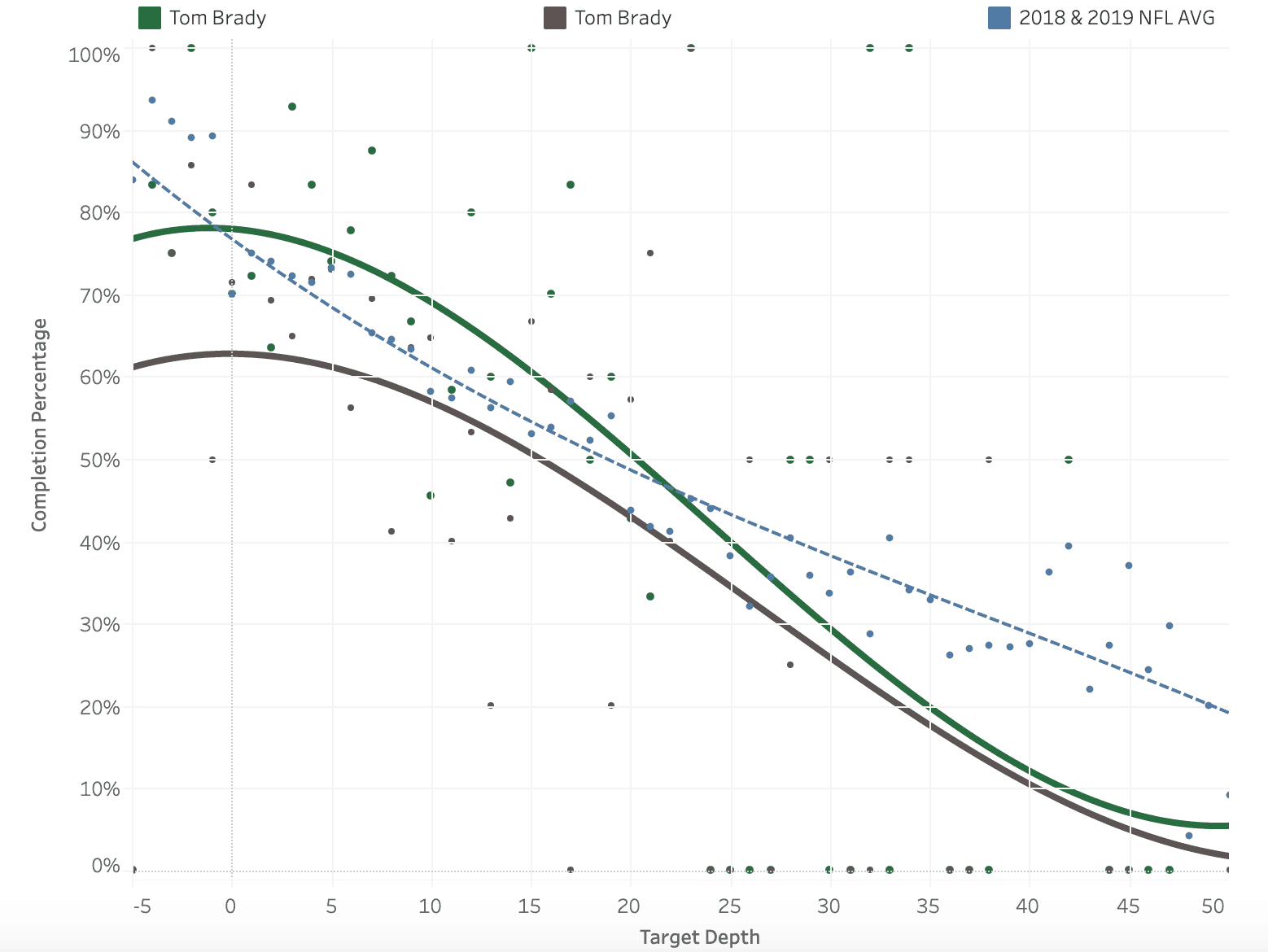
Brady’s on-target rate on short passes dropped slightly in 2019, per Sports Info Solutions charting, but the accuracy drop was nowhere near the completion percentage decline to that area of the field. Wherever Brady plays in 2020, an emphasis on receivers who can win in the short game could help get the best out of the quarterback.
Opposites Attract: Jameis Winston vs Philip Rivers
Jameis Winston is the current quarterback of the Tampa Bay Buccaneers. Philip Rivers has been rumored as a an option for the next quarterback of the Tamp Bay Buccaneers. There might not be two quarterbacks who reflect different styles and skillsets in this free agent class.
We all know Winston has the tendency to be aggressive down the field — sometimes too aggressive — but even with the interceptions, Winston has been an above-average deep passer. That meshes with the “no risk it, no biscuit” philosophy of Tampa Bay head coach Bruce Arians.
Rivers, on the other hand, still has that aggression in him at times but at this point in his career, he doesn’t always have the arm strength to pull it off. Rivers has picked up the short to intermediate efficiency we mentioned usually comes through in successful aging quarterbacks, though his play there is not significantly better than Winston, who was average to below-average in those areas in 2019. The advantage there also doesn’t nearly make up for the big plays Winston can make in the more valuable areas down the field.
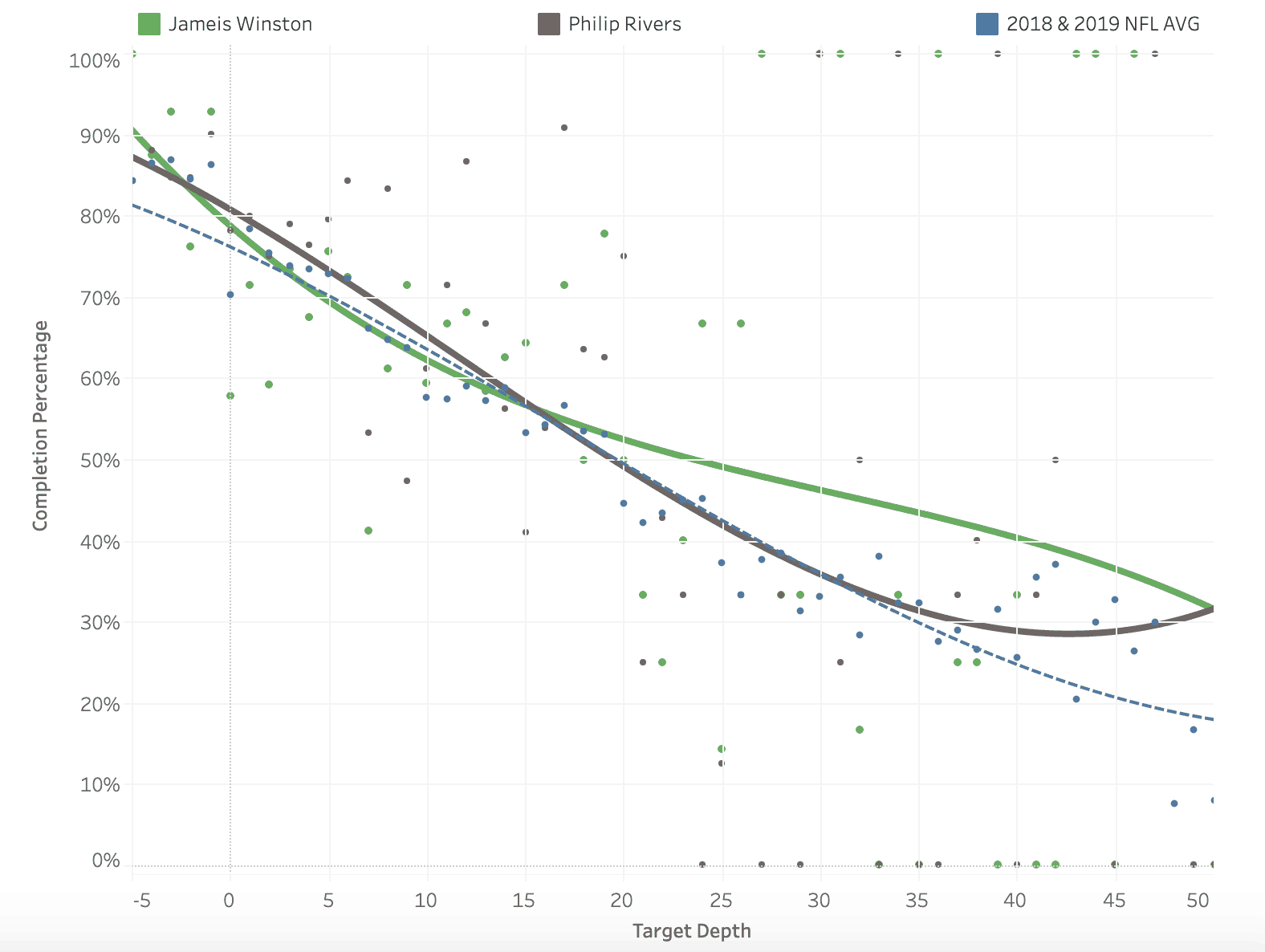
Rivers doesn’t even come with lower risk on downfield passes. On throws that traveled at least 20 yards in the air during the 2019 season, Rivers had more interceptions (9) than Winston (7) with 28 fewer attempts.
It’s hard to find a quarterback who better embodies an Arians-type quarterback than Winston, especially if various healed injuries and better eyesight could help decrease the turnovers. Rivers doesn’t seem like a fit in that type of vertical offense and would likely be a better addition somewhere like Indianapolis where there can be a bigger focus on short to intermediate throws.
Playing it safe with Teddy Bridgewater
If there’s s stranger fit as a rumored future Buccaneer than Rivers, it’s Teddy Bridgewater. Bridgewater filled in admirably during the five-game stretch Drew Brees missed in New Orleans but much of his success came on shorter passes. Per Next Gen Stats, Bridewater’s 6.2 aDOT was the lowest of any qualified quarterback in 2019. That meshes with where Bridgewater was the best by completion percentage last season:
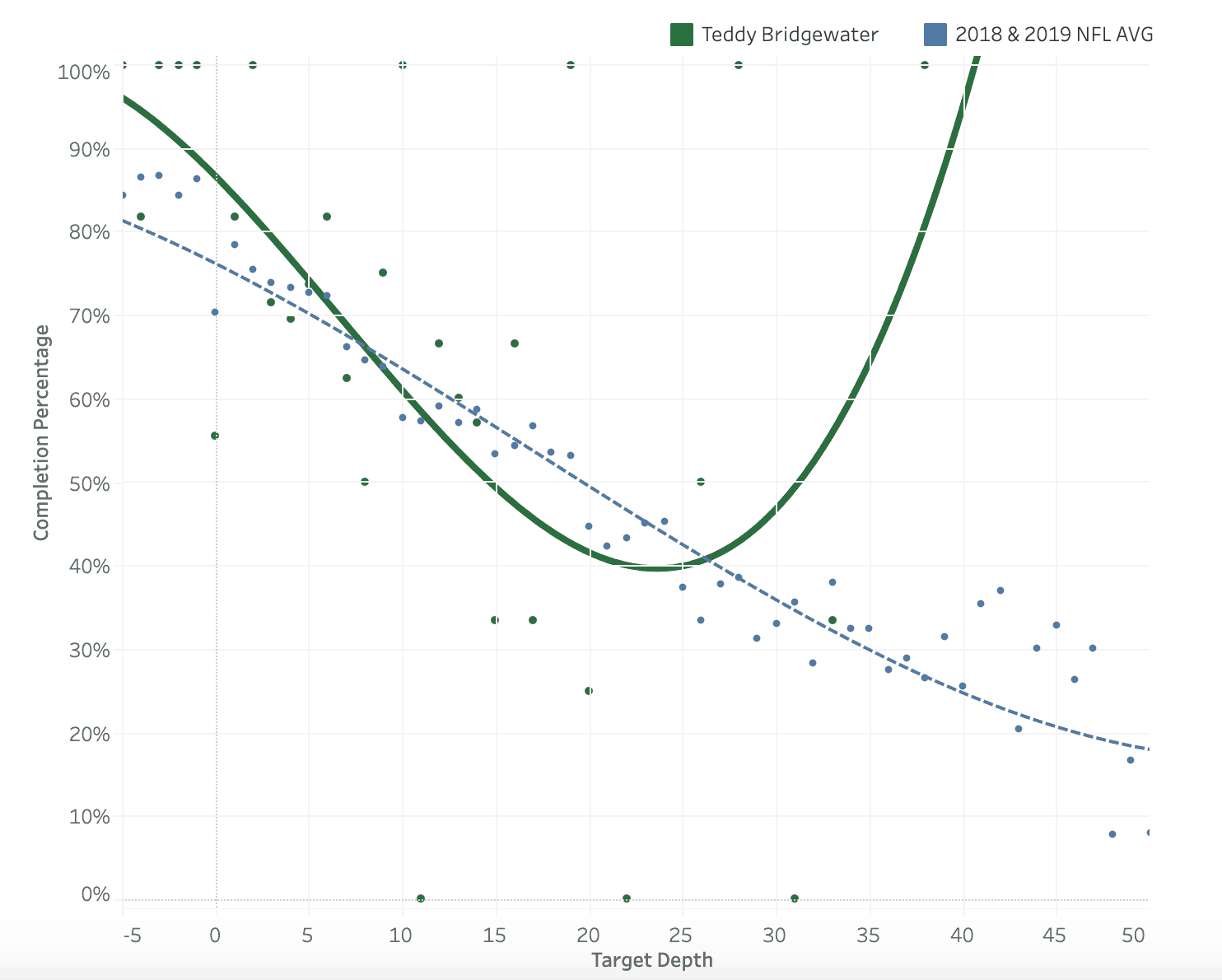
This isn’t to say Bridgewater is destined to become the worst-case version of Derek Carr in full check-down mode, but Bridgewater has always excelled more with those short and intermediate throws. Even back in 2015 with the Minnesota Vikings, there was some disconnect with elements of Norv Turner’s then more vertical offense.
Still, Bridgewater is only 27 years old (28 in November) and just a month older than Carson Wentz, who was drafted two years after Bridgewater. He’s another quarterback who makes more sense in a West Coast type system rather than Arians’s vertical attack but with his youth and experience, there’s still plenty of upside in Bridgewater as a 2020 starting quarterback.
The Secret to Ryan Tannehill's Success
No quarterback had a more surprising season than Ryan Tannehill. After seven meh to fine years with the Miami Dolphins, Tannehill became one of the most efficient quarterbacks in the league over the second half of the season with the Tennessee Titans.
With the Titans, Tannehill became one of the most dangerous quarterbacks with play-action, especially on passes that traveled up to 15 yards in the air.
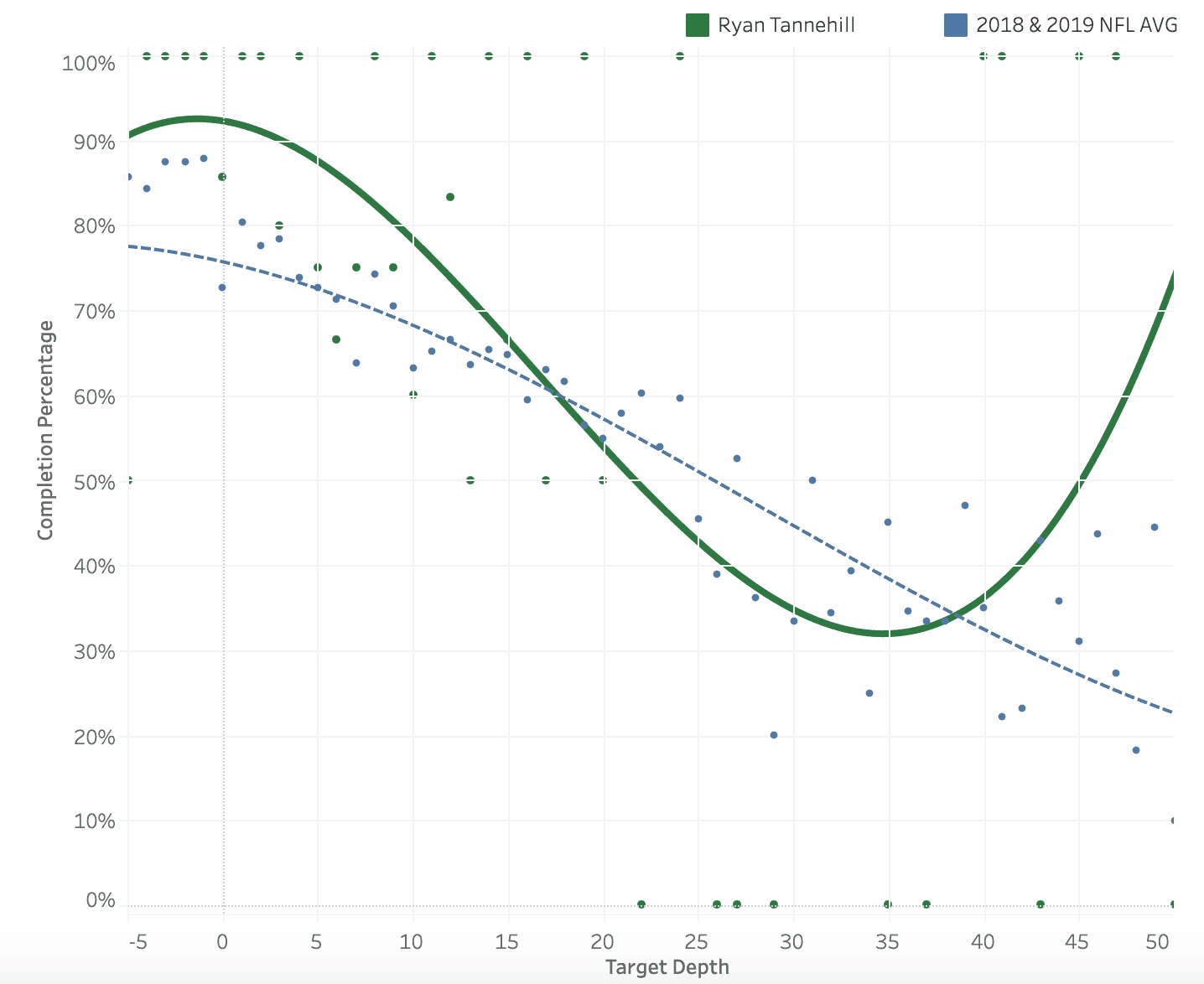
Even without play-action, Tannehill was well above league average on shorter passes, though without a play-fake the success topped out around 10 yards beyond the line of scrimmage.
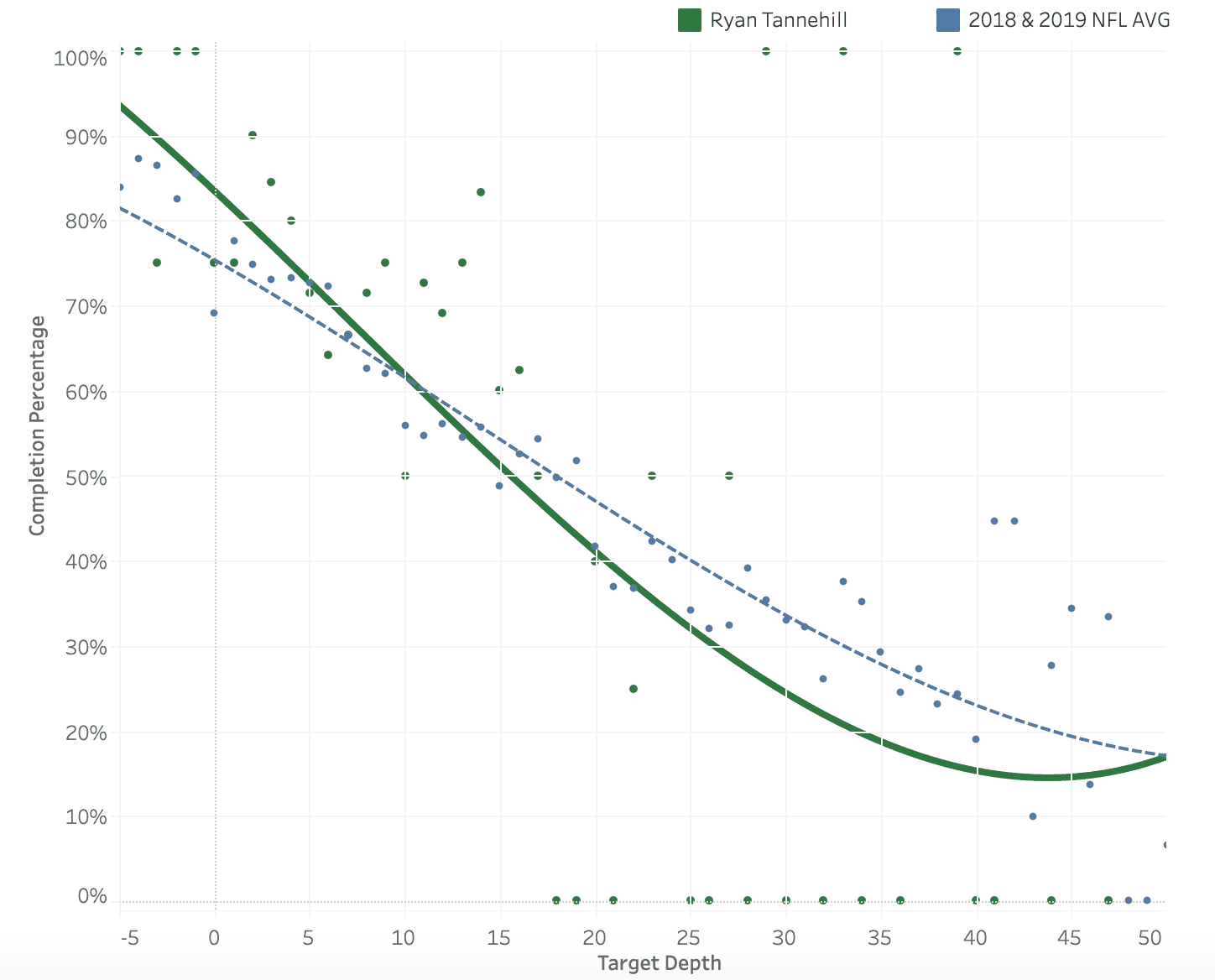
Much of this worked in Tennessee thanks to receivers who could get open quickly and run after the catch — a specialty of first-round pick A.J. Brown. We dove into Tannehill’s unreal success on intermediate throws during the regular season and the question now becomes how much of that is sustainable from the quarterback perspective.
With play-action and even more without it, Tannehill wasn’t an effective deep thrower. The Titans were able to get by thanks to the short passes and YAC but that might not be as effective if Tannehill drops to even league-average efficiency on those throws.
The Titans might in a place where the franchise tag is the best option to see how much Tannehill can replicate as long as the team is also ready to figure out the future at quarterback and not bank on likely unsustainable success sticking around in 2020.
Mariota’s Next Stop
When Tannehill took over for the Titans, Marcus Mariota was pushed out of the starting gig. Between injuries and a number of coaching changes, Mariota was never able to live up to the billing of a No. 2 overall pick. Now, entering free agency, Mariota could be this year’s version of Tannehill (though he was acquired in a trade) as a cheap option to backup an underperforming quarterback nearing the end of his rookie deal.
The place mentioned most often is the Chicago Bears to push Mitchell Trubisky. Mariota’s connection to Chicago made more sense when former Oregon head coach Mark Helfrich was the offensive coordinator, but he was replaced earlier this offseason. Still, Mariota makes sense as a low-cost option that could serve as insurance or as an eventual replacement for Trubisky.
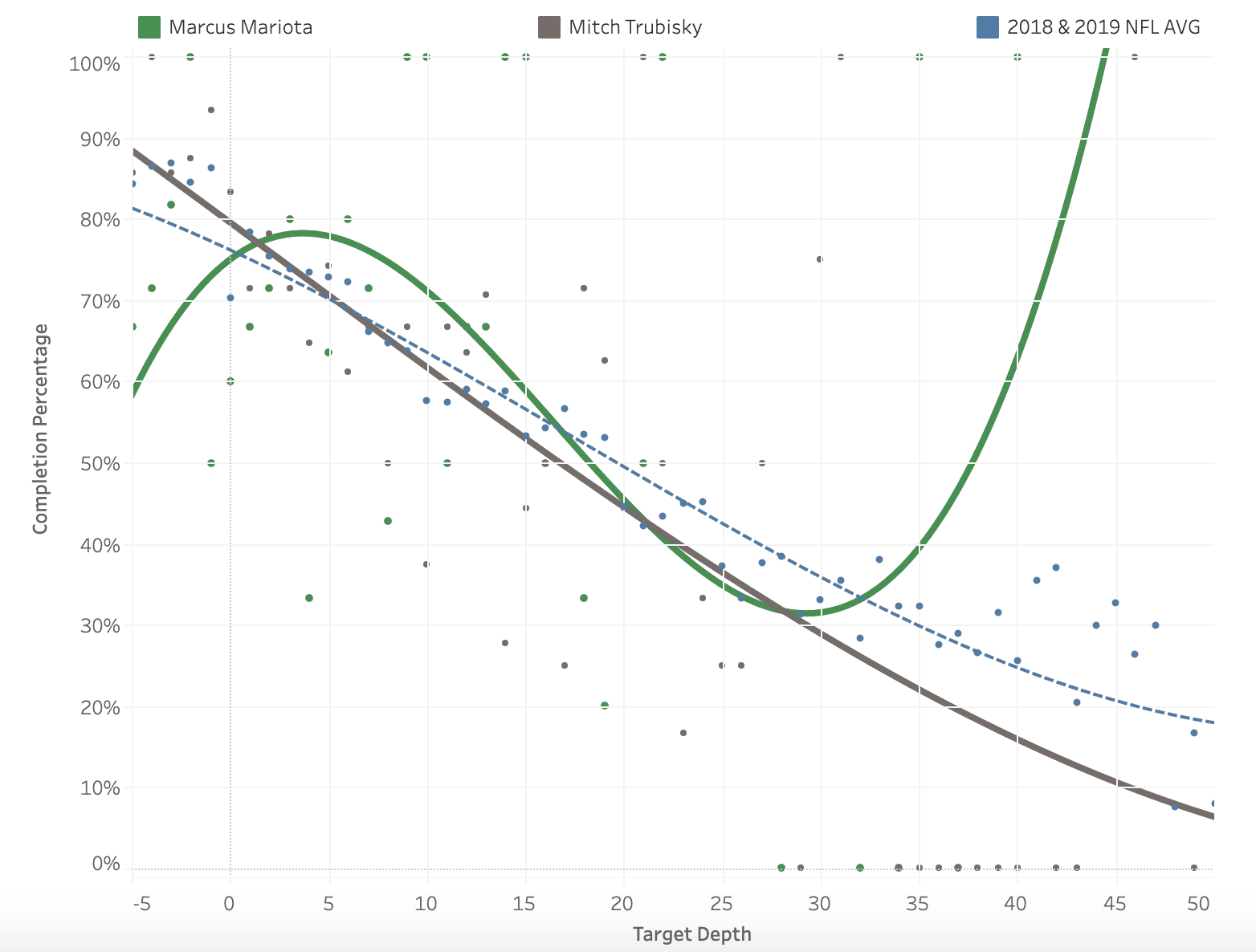
Many of Mariota’s struggles in 2019, surprisingly, came on throws behind the line of scrimmage. He was able to find success — significantly more than Trubisky — on intermediate throws last season. His deep ball wasn’t effective past 15 yards but neither was Trubisky’s.
Mariota might not be a long-term answer for any team in need of a quarterback, but he could fill the high-level backup/capable spot starter role teams like the Bears could use.


